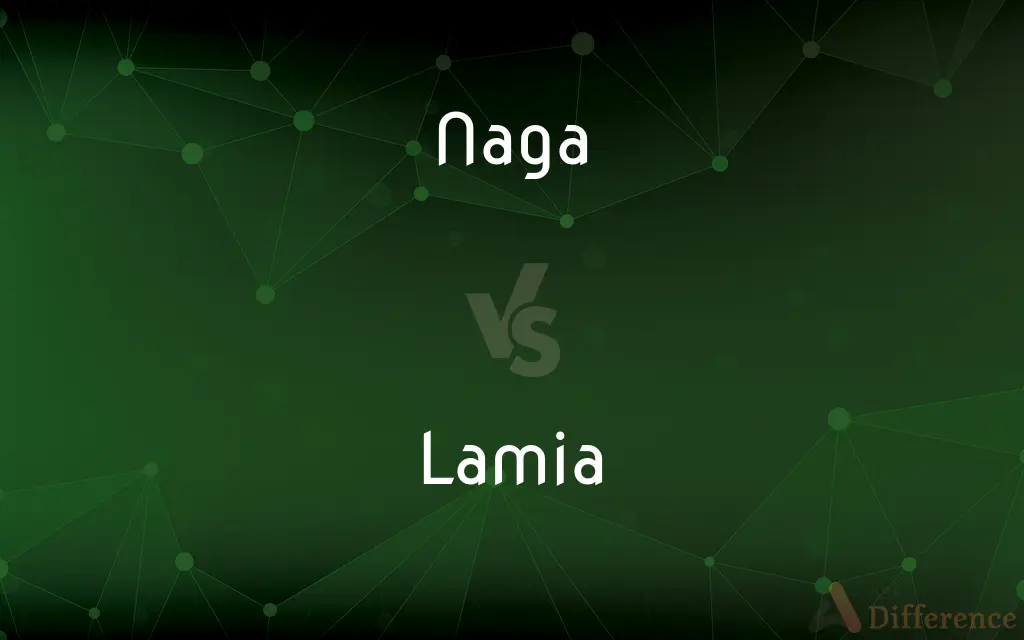Naga vs. Lamia — What's the Difference?
By Maham Liaqat & Fiza Rafique — Updated on February 29, 2024
Nagas are mythological serpents from Hindu/Buddhist traditions with human heads, embodying water and fertility. Lamias from Greek mythology have female human upper bodies and serpent lower bodies, known for seducing young men.

Difference Between Naga and Lamia
Table of Contents
ADVERTISEMENT
Key Differences
Nagas have their roots in Hindu and Buddhist mythology, revered as semi-divine beings associated with water, fertility, and sometimes guardianship. Lamias find their origin in Greek mythology, often portrayed as malevolent entities with a tragic backstory, cursed to become monsters that prey on humans.
Nagas are frequently depicted as beings with the lower body of a serpent and the upper body of a human, capable of changing shape. They can be either male or female. Lamias are generally described as having the upper body of a woman and the lower body of a serpent or sometimes depicted wholly as serpentine beings with female faces.
Nagas carry a more ambivalent symbolism, ranging from protectors to deities associated with water and fertility. Lamias, however, are often seen through a darker lens, symbolizing the dangers of seduction and the corruption of innocence, acting as cautionary figures.
Nagas play various roles in myths, from guardians of treasures and otherworldly realms to beings of significant religious importance, participating in stories of creation, protection, and cosmic balance. Lamias' stories are more focused on their interactions with humans, primarily through tales of seduction, revenge, and the tragic loss, serving as antagonists or tragic figures.
Comparison Chart
Cultural Origin
Hindu and Buddhist mythology.
Greek mythology.
ADVERTISEMENT
Physical Form
Human head with serpent body, shape-shifters.
Female upper body, serpent or fish-like lower body.
Symbolism
Water, fertility, protection, sometimes malevolence.
Seduction, danger, malevolence.
Role in Myths
Protectors, deities, symbolic beings.
Monsters, seducers, cautionary figures.
Gender
Can be male or female.
Primarily female.
Compare with Definitions
Naga
Mythological serpent beings with divine attributes.
The Naga king protected the precious gem from intruders.
Lamia
Known for seducing and devouring young men.
The Lamia in the tale was feared for preying on the village's young men.
Naga
Shape-shifters capable of assuming human form.
The Naga transformed into a human to interact with the villagers.
Lamia
Mythological creatures with a woman's upper body and a serpent's lower body.
The Lamia lured unsuspecting travelers with her beauty.
Naga
Associated with fertility and rain in agriculture.
Farmers revered Nagas for their ability to bring rain.
Lamia
Cursed figures with a tragic backstory.
The Lamia was once a queen, cursed by the gods into monstrosity.
Naga
Featured in both Hindu and Buddhist temple art.
The temple's entrance was adorned with Naga sculptures.
Lamia
Symbols of caution in Greek stories.
Parents told stories of the Lamia to warn their children of the dangers of strangers.
Naga
Guardians of the underwater world and treasures.
Nagas were said to guard the bottom of the ocean.
Lamia
Occasionally depicted as vampiric entities.
Some tales described the Lamia sucking the life force from her victims.
Lamia
Lamia (; Greek: Λάμια), in ancient Greek mythology, was a child-eating monster and, in later tradition, was regarded as a type of night-haunting spirit (daemon). In the earliest stories, Lamia was a beautiful queen of Libya who had an affair with Zeus.
Common Curiosities
Do Nagas and Lamias have any similarities?
Both are mythological serpent beings with human characteristics, but their origins, roles, and cultural significances are distinct.
What is the primary cultural difference between Nagas and Lamias?
Nagas originate from Hindu and Buddhist cultures, embodying elements of divinity and protection, whereas Lamias are from Greek mythology, often embodying seduction and malevolence.
What roles do Nagas play in their myths?
Nagas can be guardians, deities, or significant religious symbols, often associated with water, fertility, and protection.
Are there any modern interpretations of Nagas and Lamias?
Both have been adapted into various forms of modern media, including literature, film, and video games, sometimes blending their traditional attributes with contemporary storytelling.
Why are Lamias depicted negatively?
Lamias are often seen as cautionary figures, embodying the dangers of seduction and the corruption of innocence, reflecting ancient fears and moral lessons.
How do Nagas interact with humans in myths?
Nagas can interact with humans as protectors, sometimes as adversaries, but often they have a complex relationship that involves both benevolence and wrath.
What does the Lamia symbolize in Greek mythology?
The Lamia symbolizes the darker aspects of human nature and the consequences of divine wrath, often serving as a warning against moral transgressions.
Can Nagas be both male and female?
Yes, Nagas can be depicted as either male or female, unlike Lamias, who are predominantly female.
What is the significance of Nagas in religious contexts?
In Hinduism and Buddhism, Nagas are sometimes worshipped as deities associated with water and fertility, playing significant roles in religious texts and rituals.
Can Lamias change their form like Nagas?
Traditional myths primarily depict Lamias with fixed forms, unlike Nagas, who are often described as capable of shape-shifting.
Is there a historical basis for the myths of Lamias?
The myth of the Lamia may have originated from real historical figures or events, later evolving into the legendary stories known today.
What lessons do the stories of Lamias teach?
Lamia stories often serve as cautionary tales about the dangers of succumbing to temptation and the importance of moral vigilance.
How have perceptions of Nagas and Lamias changed over time?
While traditional perceptions remain influential, modern reinterpretations have often humanized these beings, exploring their complexities and moral ambiguities in new ways.
How are Nagas and Lamias represented in art and architecture?
Nagas are commonly depicted in South and Southeast Asian temple art and architecture, while Lamias are less commonly represented in classical art, often depicted in modern illustrations based on ancient descriptions.
Do Nagas have any weaknesses?
Specific myths mention various weaknesses of Nagas, often related to magical or divine interventions, but these vary widely across stories.
Share Your Discovery

Previous Comparison
Polypropylene vs. Polyolefin
Next Comparison
Melancholy vs. PoignantAuthor Spotlight
Written by
Maham LiaqatCo-written by
Fiza RafiqueFiza Rafique is a skilled content writer at AskDifference.com, where she meticulously refines and enhances written pieces. Drawing from her vast editorial expertise, Fiza ensures clarity, accuracy, and precision in every article. Passionate about language, she continually seeks to elevate the quality of content for readers worldwide.
















































